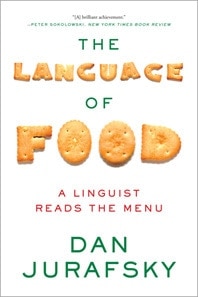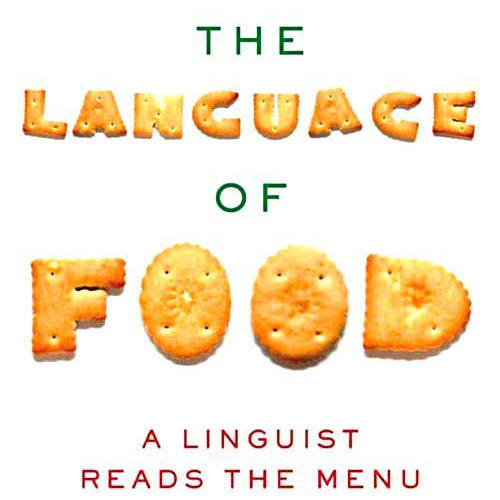Dan Jurafsky, computational linguist at Stanford University, achieved what many academics only dream of when his blog The Language of Food – a collection of quirky linguistic investigations into the history and sociology of food – was published as a mass market book. The book promises to “peel away the mysteries from the foods we think we know” (book jacket copy) by illuminating the etymologies of iconic food items like ketchup and applying regressions to large datasets to reveal patterns across menus and restaurant reviews. The wandering musings that worked so well in the blog format unfortunately translate into a book with not much cohesion, held together most obviously by constant references to the author’s hometown (San Francisco) and wife (Janet).
Nevertheless, the book is an accessible and entertaining romp through various aspects of the culture and history of food with stops included from thousand year old Persian cookbooks all the way to ice cream made with liquid nitrogen.
The book is comprised of thirteen chapters each standing on their own that needn’t be read in succession. Eight chapters deal with the history of certain culinary terms that usually 
In another four chapters, Jurafsky describes the more sociological aspects of the language of food and consumption not only through the analysis of large datasets but also by introducing concepts such as sound symbolism. Jurafsky shows us the linguistic indicators on menus that distinguish expensive restaurants from mid-range and cheap restaurants. Similarly, a study of restaurant reviews reveals that the metaphors used for positive descriptions of food also differ depending on whether the food is expensive or affordable, that a lot of languages have a limited set of descriptors for taste, and that descriptors of tasty foods vary across cultures. In a chapter that begins with the commonalities of names for ice cream versus names for crackers and chips, sound symbolism is introduced to argue that while there are certain almost universal synesthetic associations in the abstract (front vowels refer to small, thin, light things; back vowels refer to big, fat, heavy things), the extent to which these sounds are associated with cultural objects is a matter of socialised conventions. Finally, Jurafsky introduces the only ‘theoretical’ contribution to the book by arguing that cuisines, like languages, are governed by a ‘grammar’ that determines conventions of meal order and acceptable flavour pairings. He believes that this grammar in part explains how and why new foods introduced into a cuisine are changed in order to be acceptable to that cuisine’s grammatical conventions.
The book familiarises the reader with a great variety of food items and their histories across large swaths of the world. Many different culinary traditions and technologies are touched upon that will delight food enthusiasts. Jurafsky also makes a point of correcting some common (ethnocentric) misconceptions, great and small. One such idea was that an isolated China was somehow dragged into wealth by the Europeans; rather, it was British, Dutch, and Portuguese eagerness to tap into the vibrant trade going on in East Asia that drove colonial exploration. Likewise, stereotypically ‘medieval’ sweet and savoury dishes combining meats with dried fruits, ginger, and other spices were actually spread to Europe through Muslim Andalusia and Sicily. Jurafsky deftly chronicles the vast borrowing and profound interconnectedness of culinary cultures throughout history, showing that notions of globalisation or ‘fusion’ are certainly not new when it comes to cuisine. The writing is accessible and Jurafsky skilfully employs historical sources, sometimes to great comedic effect (examples to chuckle at include “language mavens” complaining about changing usage, p. 95).
The book’s coverage of great breadth sometimes leads to overly facile periodisations and simplistic oppositions such as ‘ancient’ or ‘traditional’ versus ‘modern’. The constant references back to San Francisco may be charming for Bay Area residents (and probably made a lot of sense in the blog) but it came across to me as a narcissism of the local. Furthermore, the mass market format probably led to some of the exaggerated and disputable claims about universal features of human language that Jurafsky tries to push in the chapter on restaurant reviews.
These types of claims are also sometimes due to researchers basing their studies on so-called “WEIRD” (Western, Educated, Industrialised, Rich, Democratic) populations, which Jurafsky does by focusing on restaurant reviews in several large American cities.
This oversight is all the more surprising because Jurafsky cites and describes cross-cultural studies that contradict his claims. Similarly, he shows a keen understanding of the social stratification that runs through cultural practices of food consumption in some of his chapters, but the extremely tight link between food and social class is elided in a lot of the historical chapters. Finally, scholars of language not convinced by the methods of computational linguistics might also find that the chapters employing these methods do not adequately address the complexity of the phenomena studied. For example, including both restaurant reviews and tasting notes in a corpus of text to be analysed ignores the differences in genre, and thus also history, function, and audience between these two types of writing. This may explain why Jurafsky seems surprised that restaurant reviews tend to focus more on the general service experience than the sensory qualities of the food itself (as a tasting note does).
Overall, the book is an entertaining light read for food enthusiasts who won’t be dismayed by the lack of critical depth and overall cohesiveness. Scholars of language, food as cultural practice, and culinary history could be entertained as well but might be better off seeking out Jurafsky’s academic research outputs for a more complex engagement with the topic.
Jurafsky, Dan. 2014. The Language of Food: A Linguist Reads the Menu. New York: W. W. Norton & Company. 272pp. Hb: $26.95. ISBN: 9780393240832.






